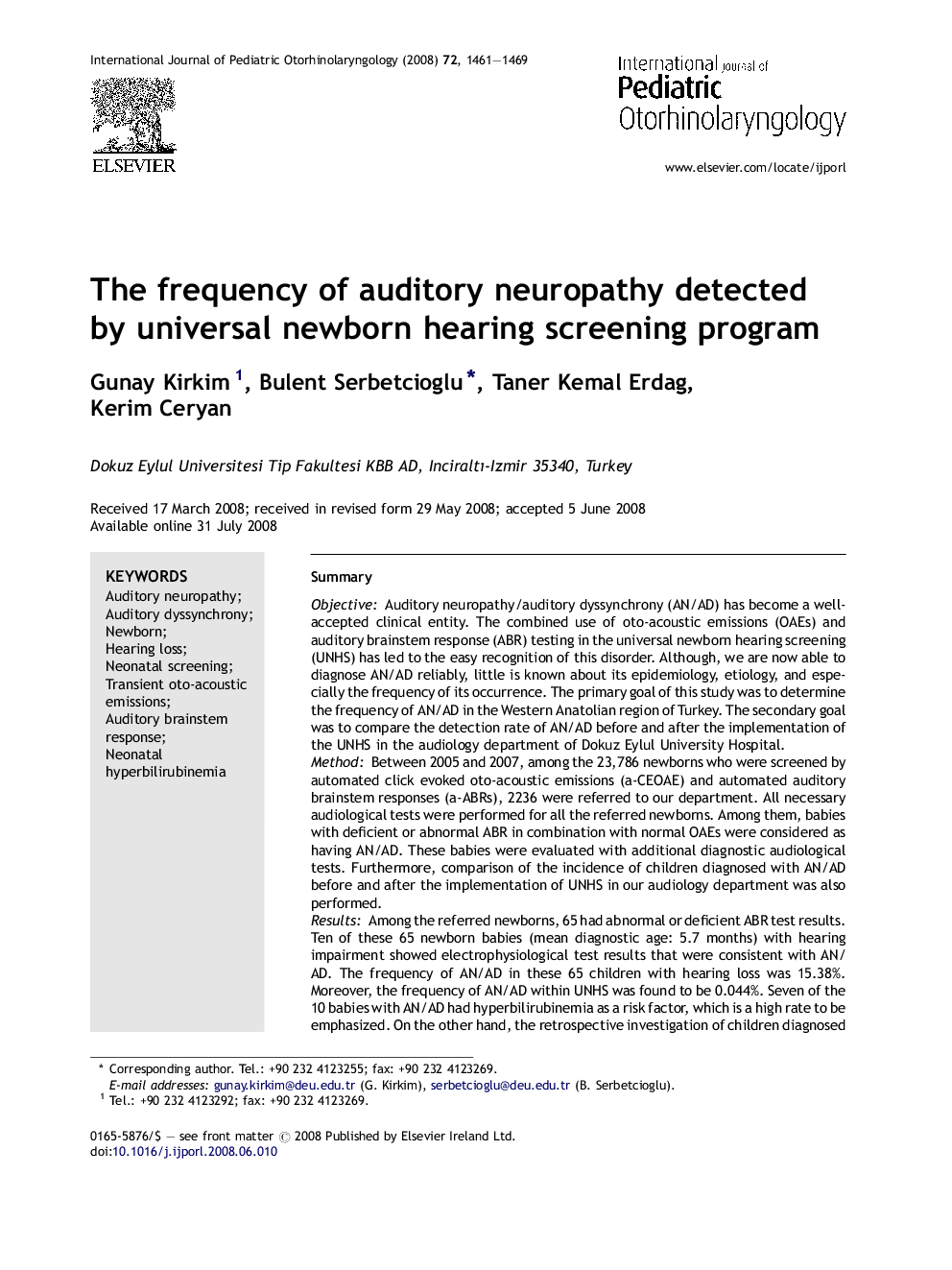| کد مقاله | کد نشریه | سال انتشار | مقاله انگلیسی | نسخه تمام متن |
|---|---|---|---|---|
| 4114911 | 1606078 | 2008 | 9 صفحه PDF | دانلود رایگان |

SummaryObjectiveAuditory neuropathy/auditory dyssynchrony (AN/AD) has become a well-accepted clinical entity. The combined use of oto-acoustic emissions (OAEs) and auditory brainstem response (ABR) testing in the universal newborn hearing screening (UNHS) has led to the easy recognition of this disorder. Although, we are now able to diagnose AN/AD reliably, little is known about its epidemiology, etiology, and especially the frequency of its occurrence. The primary goal of this study was to determine the frequency of AN/AD in the Western Anatolian region of Turkey. The secondary goal was to compare the detection rate of AN/AD before and after the implementation of the UNHS in the audiology department of Dokuz Eylul University Hospital.MethodBetween 2005 and 2007, among the 23,786 newborns who were screened by automated click evoked oto-acoustic emissions (a-CEOAE) and automated auditory brainstem responses (a-ABRs), 2236 were referred to our department. All necessary audiological tests were performed for all the referred newborns. Among them, babies with deficient or abnormal ABR in combination with normal OAEs were considered as having AN/AD. These babies were evaluated with additional diagnostic audiological tests. Furthermore, comparison of the incidence of children diagnosed with AN/AD before and after the implementation of UNHS in our audiology department was also performed.ResultsAmong the referred newborns, 65 had abnormal or deficient ABR test results. Ten of these 65 newborn babies (mean diagnostic age: 5.7 months) with hearing impairment showed electrophysiological test results that were consistent with AN/AD. The frequency of AN/AD in these 65 children with hearing loss was 15.38%. Moreover, the frequency of AN/AD within UNHS was found to be 0.044%. Seven of the 10 babies with AN/AD had hyperbilirubinemia as a risk factor, which is a high rate to be emphasized. On the other hand, the retrospective investigation of children diagnosed with AN/AD in the same audiology department between 1999 and 2005 (i.e. before the implementation of UNHS) revealed only 7 children, with an average diagnostic age of 34 months.ConclusionAfter implementing the UNHS, the incidence of AN/AD in the audiology department increased from 1.16 to 4.13. Furthermore, the age of diagnosis of AN/AD decreased from 34 months to 5.7 months. This study shows that AN/AD, when screened, is a comparatively common disorder in the population of hearing-impaired infants. While newborn hearing screening provides early detection of babies with hearing loss, it also helps to differentiate AN/AD cases when the screening is performed with both a-ABR and automated oto-acoustic emission (a-OAE) tests. Thus, the routine combined use of a-ABR and a-OAE tests in UNHS programs, especially for the high-risk infants, can provide better detection of newborns with AN/AD. Furthermore, hyperbilirubinemia is merely an association and maybe etiologically linked.
Journal: International Journal of Pediatric Otorhinolaryngology - Volume 72, Issue 10, October 2008, Pages 1461–1469